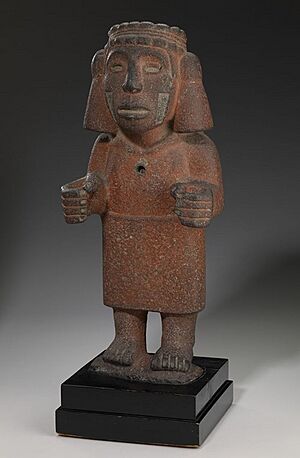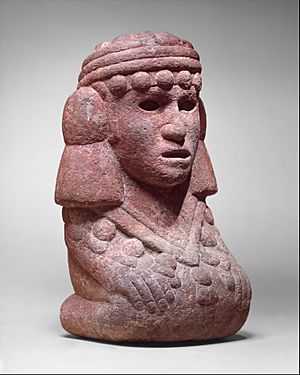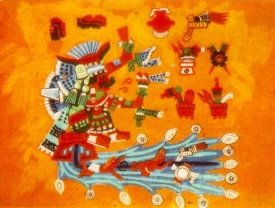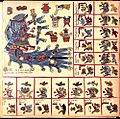Chalchiuhtlicue facts for kids
Chalchiuhtlicue (say: Chal-chee-oot-lee-kweh) was an important Aztec goddess of water. She was known for rivers, seas, storms, and even baptism. Chalchiuhtlicue was also linked to making things grow and was seen as a protector of childbirth.
People in the Aztec Empire, especially in central Mexico, highly respected her before the Spanish arrived. She was a key figure among the Aztec rain gods and was closely related to another water god named Chalchiuhtlatonal.
Contents
Who Was Chalchiuhtlicue?
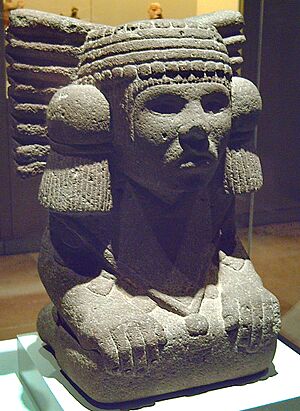
Chalchiuhtlicue's name means "Jade her skirt," but it's usually understood as "she of the jade skirt." Jade was a very precious stone to the Aztecs. She was also called Chalchiuhtlatonac, meaning "She Who Shines Like Jade." Another name, Matlalcueye, meaning "Possessor of Blue Skirt," was used by the Tlaxcalans, a group of people who lived in the area of Tlaxcala.
In Aztec beliefs, Chalchiuhtlicue was either the wife or sister of Tlaloc, the Aztec god of rain. Both Chalchiuhtlicue and Tlaloc were water deities. However, Chalchiuhtlicue was often connected to underground water, while Tlaloc was more about rain. She was also believed to be the mother of Tecciztecatl, the Aztec moon god. Some stories also say she was the wife of Xiuhtecuhtli, an older Aztec god.
Chalchiuhtlicue helped Tlaloc rule a special paradise called Tlalocan. She was thought to bring good harvests and protect women and children. Myths also say that Chalchiuhtlicue once "ate" the sun and the moon. Like many Aztec water gods, she was often linked with snakes.
How She Was Shown
Chalchiuhtlicue is easy to spot in Aztec art. She wears a special headdress made of wide bands, possibly cotton, decorated with amaranth seeds. Large round tassels hang from the sides of her headdress. She also usually wears a shawl with tassels and a skirt. Often, she is shown sitting with water flowing from or behind her skirt.
In ancient Aztec books called codices, Chalchiuhtlicue appears in different ways:
- In the Codex Borbonicus (page 5), she has a fancy blue and white headdress. She sits on a red stool, and water flows from beneath it. A baby boy and girl are shown swimming in the water.
- In the Codex Borgia (page 65), she sits on a red throne with a river flowing behind her. Two figures stand in the water, and Chalchiuhtlicue gestures towards them. She wears a detailed yellow headdress.
Celebrations and Rituals
Five of the twenty main celebrations in the Aztec calendar were dedicated to Chalchiuhtlicue and Tlaloc. During these events, priests would dive into a lake. They would move and make sounds like frogs, hoping to bring rain.
Chalchiuhtlicue was also connected to specific days in the Aztec calendar. Her main festival was celebrated during the month of Etzalqualiztli. Because she was linked to growing crops and helping people have children, the Aztecs would ask Chalchiuhtlicue for good harvests.
Special ceremonies called Atlcahualo were held for Chalchiuhtlicue and other gods of childbirth and water. These ceremonies took place throughout the month of February.
Her Role in Childbirth
Chalchiuhtlicue was seen as the protector of children and newborns. This made her very important during childbirth. Midwives, who helped mothers give birth, played a key role. During labor, a midwife would speak to the newborn. She would ask the gods to give the baby a special place among them.
After the umbilical cord was cut, the midwife would wash the new baby. She would greet Chalchiuhtlicue as part of this custom. Four days after birth, the child would have a second bath and be given a name.
Midwives would speak words of blessing and protection. They would sprinkle water on the baby's head and chest. This was to welcome the child and ask Chalchiuhtlicue to protect them from difficulties. The water was seen as a way to cleanse and bring good fortune.
Images for kids
-
Chalchiuhtlicue in the upper left corner of the Codex Borbonicus.
See also
 In Spanish: Chalchiuhtlicue para niños
In Spanish: Chalchiuhtlicue para niños


